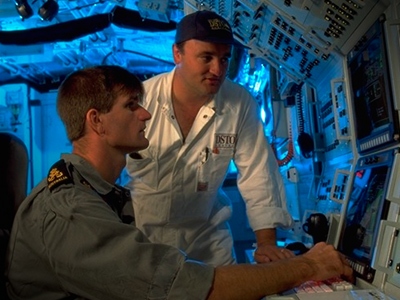Undersea Command and Control

The Undersea Command and Control branch of Maritime Division provides the science and technology (S&T) for enhancing Defence undersea warfare effectiveness through improving the collection, processing and exploitation of undersea tactical information by undersea platforms and systems.
This is achieved through the analysis and assessment of the physical, function and human elements of undersea combat and weapon systems and the integration of the associated sensor systems.
The outputs from this branch contribute to all in-service and acquisition support for Navy major surface combatant and submarine fleets and airborne underwater weapon systems.
Undersea combat systems in Australian Naval Ships
Our Undersea Combat Systems group encompasses the development, analysis and testing of combat system architectures and techniques for the integration of sensors and algorithms into combat systems.
This is achieved through functional and non-functional modeling and analysis of the computer system architectures, the use of model-based systems engineering to support combat system architecture research; the benchmarking of current and new combat system architectures; and an understanding of the operation and integration of associated sensor systems (including optronic and navigation systems) within Austraian naval ships.
A key focus for this group is examination of how modern combat system architectures can be used to minimise the space, weight and power requirements of future maritime combat systems while supporting the continual evolution of the combat system through, for example, the insertion of new algorithms.
Human systems and information integration
Our Human Systems and Information Integration group encompasses the sciences required to analyse, predict and improve the performance and processing exploitation of information collection in the underwater environment.
The outputs of the science range from assessment of tactical awareness and response from underlying tracking and data fusion algorithms to human factors engineering and cognitive sciences to analyse and improve the transfer of tactical information from the combat system to the command team.
The group incorporates the underlying sciences for the assessment of fatigue and the development of improved machine interfaces.
Undersea Weapons Systems
Our Undersea Weapons Systems group maintains and develops specialist knowledge of the functions, capability and integration issues of undersea weapon systems.
This is achieved through an understanding of undersea weapon sensor detection, homing and firing algorithm functions, along with the weapon system simulation and analysis to support performance analysis and tactical development.
Outputs from this group include detailed threat weapon analysis, which is used to support acquisition and evolution programs, improved weapon countermeasures and the provision of modelling and analysis for underwater weapon systems tactical development and assessments.
Undersea environment and warfare assessment
Our Undersea Environment and Warfare Assessment group encompasses the modelling and analysis of the undersea warfare effectiveness and susceptibility of Australian Defence Force (ADF) platforms.
The group has knowledge, skills and expertise in undersea environmental acoustics and the maintenance, development and use of models and analysis techniques for acoustic propagation, sonar system performance, undersea warfare system effectiveness and platform susceptibility.
Outputs from this group include the assessment of acoustic and non-acoustic detection, counter-detection and susceptibility of current and future systems and platforms, which inform signature reduction and management requirements and strategies to reduce susceptibility to current and emerging threats.
The outcomes are improved undersea warfare system effectiveness and reduced platform susceptibility to being detected, targeted and hit. These, in turn, help to increase the operational capabilities and mission survivability for current and future platforms.

